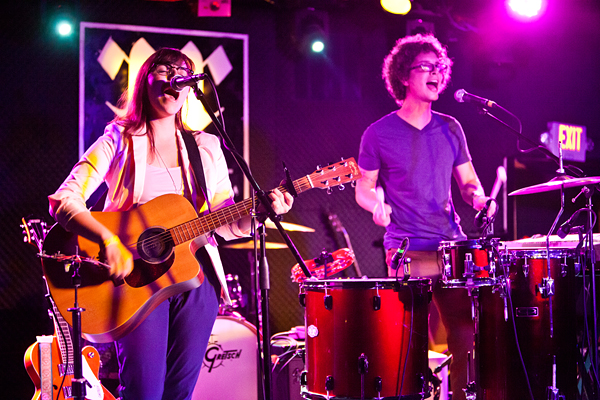Taking photos at a rock concert is awesome. Typically, the photographer gets a special press badge, up-close access to the artist, and sometimes even a backstage pass. Oftentimes, interesting lighting is already set up and the performers are creating interesting and entertaining moments throughout the show. With a little practice and some decent equipment, you can get some amazing shots.

The Killers on stage; Camera settings: 1/200 sec, f2.8, ISO 500, 200mm
Here are 5 tips for rock concert photography:
1. Leave the point-and-shoot at home
First of all, don’t even bother trying this with your iPhone or point-and-shoot. At every concert I’ve ever been to, people are taking photos with their phone over and over again, wondering why none of them will turn out. At most shows, it’s too dark and the performers too far away to get any decent images. An iPhone or point-and-shoot is also not capable of capturing the perfect moment because of the shutter lag and the time it takes to focus in a dark environment. Rock concert photography should be done with a DSLR and a lens that can focus manually.
2. Know the rules
Before you start shooting, make sure that you play by the rules. Most venues and bands have requirements you must follow if you are photographing. It’s important to follow these rules to avoid getting kicked out, never getting invited back, or having your equipment confiscated. Find out how long you can photograph, if it is the whole time or just during the first couple songs. Also find out where you can shoot from. Typically, there is a media area in front of the stage, next to the soundboard, or on a balcony. Sometimes you can wander around the venue, but I’ve found it’s helpful to stake out a spot because if the place fills up, you might be out of luck in getting a good vantage point. Most venues and bands do not allow you to use a flash, but it’s worth asking, though you have to be close for your flash to make any difference. Most importantly, don’t get in the way of the performers!
3. What to bring
For most shows, I only need a DSLR with high ISO capability, a fast wide lens, a fast zoom lens and a tripod. Being able to crank the ISO up to 1600, 3200 or higher and still get a clear image is very helpful when you are working with stage lights. I like to have fast lenses (f/2.8 or faster) to let as much light in as possible — one wide one for up-close shots and one telephoto for shooting from further away. A tripod is very helpful if you have a to shoot from the back with a long lens. It will allow you to use a slower shutter speed since you don’t have to worry about camera shake.

Alexis & the Samurai on stage; Camera settings: 1/80 sec, f2.8, ISO 6400, 70mm
4. Settings
Determine how high your camera’s ISO can go before it’s too grainy before you start shooting. I like to set my ISO at 3200. Then, I’ll set my aperture as open as it will go: f/2.8. This allows my shutter to be as fast as possible. Having a shutter speed of 1/125 or 1/250 sec is pretty good for freezing the action on fast moving performers. If my exposure allows for 1/500 or 1/1000 sec, I would rather bring my ISO noise down than have the extra shutter speed. The settings you use all depend upon how bright those stage lights are and what looks best to you. Once I have my settings dialed in, I will stay in manual mode and make slight 1-stop adjustments as the stage lights get brighter or dimmer.
5. Anticipate
Of course, once you have the settings dialed in, all you have to do is be positioned in the perfect place and anticipate the perfect moment. It’s just that easy! This comes with practice and sometimes shooting the same band over and over again. Keep your eye to the camera and be ready to click your shutter!

Share tips, start a discussion or ask one of our experts or other students a question.
No Responses to “Photography Friday: 5 Tips for Photographing a Rock Concert”